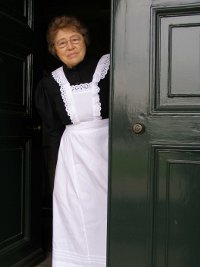
Kingston Lacy Volunteer Project (National Trust)
1890s Servants Clothing
The project at Kingston Lacy House in Dorset was originally the brainchild of the Learning Officer, Annabel Hunt
To in order to provide a unified approach to greeting and leading school parties around the house and grounds it was decided to dress the Education volunteers as the servants of the house. This was to enable the volunteers to discuss with school children a wide range of jobs and the idea of social hierarchy in the house and society.
From the start the ladies were eager to take part and while Annabel was away on secondment have even run the project themselves, arranging the meetings, raising funds and ensuring there is always a good supply of tea and homemade cakes to sustain the workers. The ladies raised almost all of the funds themselves, organising a very successful silent auction, car boot sale and book sales. One visitor was so impressed with their enthusiasm that she anonymously sent 10 £50 notes!

The group works on the clothing together so each person has been responsible for at least part of everyone else's clothing. Much unpicking has been done but also much learning of new skills. After the seventh, two day workshop, the ladies where delighted to be told that they had made 46 items of clothing including their Victorian style boned corsets - no mean feat even for experienced dressmakers!

The volunteers have enjoyed the project and great amusement has come from making corsets and underwear in the Victorian style (ably demonstrated here by one of the volunteers).
On sewing days when the house has been open to the public, visitors have been intrigued and delighted to learn of the volunteers' work. Many, regardless of nationality, have offered donations believing that supporting something that helps school children appreciate and learn about history is very worthwhile.

|

|

|

No clothing that intends to recreate the past can ever be truly authentic. Methods of sewing, construction, fabrics and the knowledge and training of the original makers can not be captured after the passing of so much time.
However, each pattern for the clothes made during this project has been developed from period sources and research on items in museum collections.
The volunteers deserve credit for the hard work they have put in to bringing these clothes to life.

If you ever visit the property be assured you will receive a warm welcome from the ladies and all the staff.
